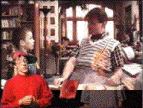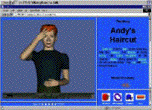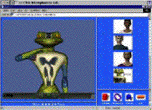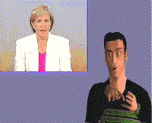| Animations are used in signing books to add visual interest, and to visualise sound and sound effects. In educational programs they can be added to visualise complex structures.
As far as we know, there are no cartoons (yet!) in sign language. Virtual - animated - scenery and props can be used to allow signers to interact with cartoon figures, to walk around in virtual real or imaginary settings, etc. In practice, few if any production teams have the resources to do this. A recent development is the use of signing robots, avatars, or sign language animations instead of human signers. |
Animations and special effects can be used to visualise relevant background sounds. A phone ringing can be visualised by an animated phone on the screen, songs by musical notes and words dancing over the screen.
Animations and special visual effects can be used to partially replace background music and sound effects, e.g. to support the mood, tension or pace in a production, provided it is functional, attractive and effective, and doesn't interfere with the visibility of the signer and the sign language.
Virtual scenery, props, and cartoon characters can be added to a video of a signer. Few production teams however, seem too have the resources to fully explore these possibilities.
A recent development that is being explored in the USA and the UK is the use of 3D animations (robots, manikins, avatars) to replace human signers. These developments are currently still in the research stage and are not yet used for 'signing books'. In the future, they may prove useful because it will be possible to adapt the signer to meet the specific requirements of a production or a viewer. For some productions, a cartoon-signer may be the preferred option, for others a very abstract, anonymous signer. In interactive productions, the user may even be able to select which signer is to present a text.
A closely related development is the use of translation software to generate the animated signer. The input for the programme is printed text, the output is an animated signer signing the story in sign language. With this software, every user will eventually be able to convert every printed text into a signing book. This development also is currently only in the research stage. For more information, see Del. 4.1.
In the Dutch production "Het Zakmes- (OV-Amsterdam, NL) a phone that is ringing is visualised as a red telephone on the screen, lighting up and fading away with each successive ring.

Red phone ringing (in the middle). Het Zakmes, OV-Amsterdam, NL
In the USA, signing 'avatars' have been developed (3D puppets on a computer screen) that sign stories in ASL and in Signed English. There are several avatars, varying in age and colour, including a signing frog. The programme was tested with Deaf children: their favourite avatar was the frog. In England, "Simon the Virtual Signer- was developed to translate printed subtitles into British Sign Language on digital television.



A signing boy avatar, and a signing frog avatar, both by Seamless Solutions, USA Simon the Virtual Signer, by Televirtual, GB